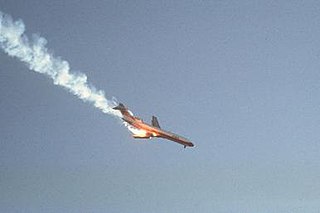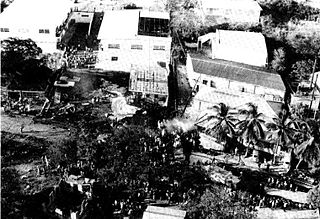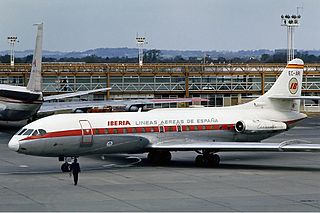
Pacific Southwest Airlines (PSA) Flight 182 was a Boeing 727-214 commercial airliner, registration N533PS, that collided with a private Cessna 172 light aircraft, registration N7711G, over San Diego, California, at 9:01 am on Monday, September 25, 1978. It was Pacific Southwest Airlines' first fatal accident, and the deadliest air disaster in California history.

Delta Air Lines Flight 1141 was a scheduled domestic passenger flight between Dallas/Fort Worth, Texas and Salt Lake City, Utah. On August 31, 1988, the flight, using a Boeing 727-200 series aircraft, crashed during takeoff, resulting in 14 deaths and 76 injuries of the 108 people on board.

Pan Am Flight 759 was a regularly scheduled domestic passenger flight from Miami to San Diego, with en route stops in New Orleans and Las Vegas. On July 9, 1982, the Boeing 727 flying this route crashed in the New Orleans suburb of Kenner after being forced down by a microburst shortly after takeoff. All 145 on board and 8 people on the ground were killed. The crash had the highest number of aviation fatalities in 1982.

United Airlines Flight 585 was a scheduled passenger flight on March 3, 1991 from Denver to Colorado Springs, Colorado, carrying 20 passengers and 5 crew members on board. The plane experienced a rudder hardover while on final approach to runway 35 at Colorado Springs Municipal Airport, causing the plane to roll over and enter an uncontrolled dive. All 25 people onboard were killed.

American Airlines Flight 625, a Boeing 727-100, crashed at St. Thomas, U.S. Virgin Islands on April 27, 1976, while on a domestic scheduled passenger flight originating at T. F. Green Airport in Rhode Island and ending at Saint Thomas, United States Virgin Islands, with an intermediate stop at John F. Kennedy International Airport. 37 out of the 88 passengers on board died in the accident.

Southwest Airlines Flight 1248 was a scheduled passenger flight from Baltimore, Maryland, to Chicago, Illinois, continuing on to Salt Lake City, Utah, and then to Las Vegas, Nevada. On December 8, 2005, the airplane slid off a runway at Chicago-Midway while landing in a snowstorm and crashed into automobile traffic, killing a six-year-old boy.

United Airlines Flight 553 was a scheduled flight from Washington National Airport to Omaha, Nebraska, via Chicago Midway International Airport. On December 8, 1972, the Boeing 737-222 serving the flight, City of Lincoln, registration N9031U, crashed during an aborted landing and go around while approaching Midway Airport.

United Airlines Flight 227 (N7030U), a scheduled passenger flight from LaGuardia Airport New York City to San Francisco International Airport, California, crashed short of the runway while attempting a scheduled landing at Salt Lake City International Airport, Utah, on Thursday, November 11, 1965.

American Airlines Flight 383 was a nonstop flight from New York City to Cincinnati on November 8, 1965. The aircraft was a Boeing 727, with 57 passengers, and 5 crew on board. The aircraft crashed on final approach to the Cincinnati/Northern Kentucky International Airport located in Hebron, Kentucky, United States. Only three passengers and one flight attendant survived the crash.

Piedmont Airlines Flight 22, a Piedmont Airlines Boeing 727-22 and a twin-engined Cessna 310 collided on July 19, 1967, over Hendersonville, North Carolina, United States. Both aircraft were destroyed and all passengers and crew were killed, including John T. McNaughton, an advisor to Robert McNamara. The aircraft were both operating under instrument flight rules and in radio contact with the Asheville control tower, though on different frequencies. The accident investigation carried out in the aftermath of the crash was the first major investigation ever conducted by the newly created National Transportation Safety Board. A review of the investigation, conducted 39 years after the crash, upheld the original findings that had placed primary responsibility on the Cessna pilot.
TWA Flight 841 was a domestic, scheduled passenger flight from John F. Kennedy International Airport in New York City, en route to Minneapolis-Saint Paul International Airport in Minneapolis, Minnesota. On April 4, 1979, at or around 9:48 p.m. Eastern Standard Time, while flying over Saginaw, Michigan, the Boeing 727-31 airliner began a sharp, uncommanded roll to the right, and subsequently went into a spiral dive. The pilots were able to regain control of the aircraft and made a successful emergency landing at Detroit Metropolitan Airport.

Alaska Airlines Flight 1866 was a regularly scheduled passenger flight operated by Alaska Airlines from Anchorage, Alaska, to Seattle, Washington, with several intermediate stops in southeast Alaska. The aircraft was a Boeing 727-100 with U.S. registry N2969G manufactured in 1966. On September 4, 1971, the aircraft operating the flight crashed into a mountain in Haines Borough, about 18 miles west of Juneau, Alaska, while on approach for landing. All 111 people aboard were killed. The subsequent investigation found that erroneous navigation readouts led the crew to descend prematurely. No definitive cause for the misleading data was found. It was the first fatal jet aircraft crash involving Alaska Airlines, and remained the deadliest single-aircraft accident in United States history until June 24, 1975, when Eastern Air Lines Flight 66 crashed.

On June 9, 1996, while operating a passenger flight from Trenton, New Jersey to Richmond, Virginia, the crew of Eastwind Airlines Flight 517 temporarily lost control of their Boeing 737-200 because of a rudder malfunction. The crew were able to regain control and land the aircraft successfully. One passenger was injured.

Iberia Flight 062 was a twin-engined Sud Aviation Caravelle registered EC-BDD operating a scheduled flight from Málaga Airport, Spain, to London Heathrow Airport. While on approach to Heathrow on 4 November 1967, the Caravelle descended far below the flight level assigned to it and flew into the southern slope of Blackdown Hill in West Sussex, killing all 37 on board.

Turkish Airlines Flight 1951 was a passenger flight that crashed during landing at Amsterdam Schiphol Airport, the Netherlands, on 25 February 2009, resulting in the deaths of nine passengers and crew, including all three pilots.

Alitalia Flight 404 (AZ404/AZA404) was an international passenger flight scheduled to fly from Linate Airport in Milan, Italy, to Zürich Airport in Zürich, Switzerland, which crashed on 14 November 1990. The Douglas DC-9-32, operated by Alitalia, crashed into the woodlands of Weiach as it approached Zurich Airport, killing all 46 people on board.

On 22 December 2009, an American Airlines Boeing 737-800, operating American Airlines Flight 331 and carrying 148 passengers and six crew, overran runway 12 on landing at Kingston in poor weather. The plane continued on the ground outside the airport perimeter and broke apart on the beach, causing injuries.

Northwest Orient Airlines Flight 6231 was the fatal crash of a Boeing 727 on December 1, 1974 in Harriman State Park near Stony Point, New York, just north of the New York City area. The Northwest Airlines 727 had been chartered to pick up the Baltimore Colts professional football team in Buffalo in western New York.

FedEx Express Flight 1478 was a scheduled domestic cargo flight from Memphis International Airport to Tallahassee International Airport. On July 26, 2002, the Boeing 727-232F aircraft flying this route crashed during landing at Tallahassee. All three flight crew members survived the accident with serious injuries, but the aircraft was destroyed.




















